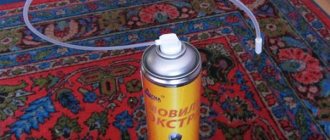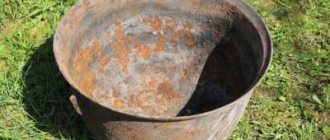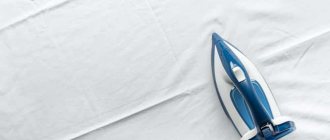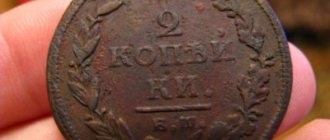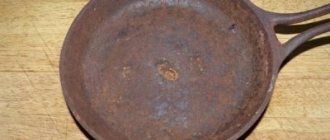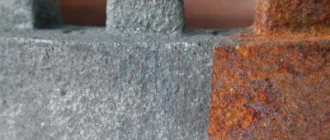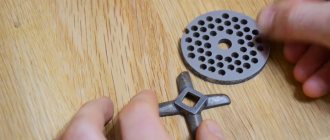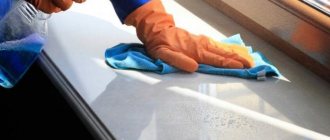What is "Movil"
"Movil" is an anti-corrosion agent that can stop the spread of rust and protect the part from damage. It was created back in the 70s of the last century by scientists from Moscow and Vilnius, during the period when the assembly of the Italian FIAT model began on the basis of the domestic VAZ.
The Italians always treated car body parts with anti-corrosion agents, but the Soviet plant did not have such compounds in its arsenal.
Initially, the product was purchased in Sweden, but VAZ management considered such costs inappropriate, and set the task for its specialists to develop an analogue, but with a cheaper and simpler composition. This is how Movil appeared in the arsenal of the Soviet automobile industry.
The domestic development was made on the same basis as a product from Sweden called Tectyl-390, but the original formula was modified, and very successfully. “Movil” was superior to the original in many respects; it began to be used not only in the USSR, but also in many European countries.
Composition of Movil
"Movil" is a film-forming agent, classified as an inhibitor, based on petroleum products or petroleum-containing products. After applying Movil to a rust-affected area of a body part, penetrant inhibitors penetrate the micropores of iron oxide, transform them into a non-corrosive form, and a durable film of resins is formed on the surface of the area.
This effect is achieved thanks to the thoughtful composition of the product. It includes:
- motor oil and drying oil,
- kerosene and solvent (white spirit),
- inhibitors and zinc,
- rust converters.
Not all formulations include transformative substances. When purchasing Movil, you should give preference to those options that have o or “with converter” on the packaging.
Most people use tannins as a converter - hydrolyzed or condensed substances that can retain and bind other components of the composition. After contact with iron oxide, tannins are converted into water-resistant tannates, which greatly increases the effectiveness of the Movil anti-corrosion agent.
Release forms of Movil and leading manufacturers
On the Russian market, this anti-corrosion agent is available in three forms at once - in the form of an aerosol or paste, in liquid form, sold in canisters with a volume of usually 3 liters.
The easiest way to work with Movil is in the form of an aerosol, but it costs much more than its analogues. For a bottle with a volume of 250 to 300 ml you will have to pay from 500 to 700 rubles. You do not need to have special skills or knowledge to treat a rusty area with an aerosol. The only rule is that you need to remove traces of corrosion from the part and always keep the bottle strictly vertical when working.
Liquid Movil, which is sold in cans, costs the least. The container is equipped with a special attachment that makes work easier. 3 liters of the product will cost no more than 450 rubles, depending on the pricing policy of the retail outlet and the starting price in the form of a paste sold in plastic or tin cans with a volume of 850 mg. It will cost from 200 to 300 rubles. In order to work with the paste, you will need to dilute it in the proportions recommended by the manufacturer with a solvent, usually white spirit.
In their reviews of the Movil product, both professionals and car enthusiasts note the products of such domestic companies as Agat-Avto, Astrokhim and Razvitie PKF.
Classification of Movils by physical condition
This classification involves division into several types:
The liquid is supplied in cans. A container with Movil with a volume of 3 liters will cost 6-7 dollars. Using liquid Movil is much easier than using a spray. You will need to get a brush or even a sponge with which you can apply the anti-corrosion material.
Movil paste is distributed in metal or plastic jars. The average cost of an 800 gram jar is about $4. The area of use for the paste is the same as for the liquid. The paste has a higher viscosity, so it must be diluted with solvent 646 - this is done right before processing.
The paste can be used to treat any body surface (arches, sills, pillars), since it also does not have any significant drawbacks.
Scope of application of anti-corrosion agent "Movil"
"Movil" is a kind of preservative that prevents contact of metal parts with moisture and other substances that cause corrosion. You can treat any body parts with this product, but you should carefully avoid getting it on plastic and rubber elements. The scope of Movil is quite wide. The product can be applied to
- body elements or their individual sections,
- welding seams after repair,
- arches and hidden cavities in hard-to-reach places,
- side members and door pockets,
- hood and trunk elements,
- "casings" of headlights, floor coverings and other parts.
Experts recommend processing the entire body, even if only one part has been replaced, and spot welding repairs have been performed.
It is strictly not recommended to treat body parts from the inside of the cabin with Movil. The fact is that it has a specific chemical smell that lasts for quite a long time. Those who cannot tolerate such aromas or those who are allergic to substances included in Movil simply will not be able to use the car.
Video
For those who don't like to read, after watching this video you will know what MOVILLE is?
And this video received several thousand likes for useful advice. How to remove saffron milk caps in 5 minutes.
Improved new mobile in a can.
The bodies of modern cars are able to withstand through corrosion for an average of 5 to 10 years, then gradually the rust begins to “eat up” the body parts, and over time, pockets of rust appear on the bottom and wheel arches. To ensure that the body iron lasts as long as possible, special protective agents are used, in particular, Movil is used to treat the lower part and hidden cavities of the body.
The anti-corrosion coating protects the metal from premature rusting, which occurs as a result of the negative influence of the environment; the metal corrodes due to interaction with water (moisture) and oxygen. Various bitumen mastics and special chemical compositions applied to body iron allow you to extend the life of the metal and delay the next repair.
How to use Movil
For any form of release of the anti-corrosion agent, the manufacturer includes instructions for its use. It is important to understand that if you simply apply the composition to the area of the body where rust has formed, it will not disappear anywhere. It is necessary to carry out the preparatory work correctly:
- clean the car from dirt and road reagents, dry it thoroughly,
- clean the area with traces of rust - with sandpaper, grinder, grinder or brush,
- rinse the surface again, preferably with a stream of running water, dry it,
- apply the anti-corrosion compound following the attached instructions for its use,
- if necessary, apply one or more layers of Movil.
Important: if several layers of anti-corrosion agent are applied, then each layer must be thoroughly dried, preferably naturally.
Using the same principle, you can treat the entire car body twice a year, after first cleaning and drying the areas where traces of rust have appeared. Such body maintenance will protect its parts from the negative effects of atmospheric phenomena (rain, sun rays), reagents that are scattered along the roads in winter.
The correct way to apply Movil
Few people go to a service station to have their body treated against corrosion. Because it’s expensive, and you don’t know how they’ll do it. Therefore, it is best to protect the body from rust with your own hands. Properly applied coating lasts for several years.
Expensive special equipment is not required to apply Movil. If you take liquid Movil, then you will need a sprayer (for example, the one used to process potatoes). If there is no sprayer, then it can be applied with a brush. Movil must be diluted with a solvent, for example, White Spirit or No. 646 solution.
In order for the applied anticorrosive to serve for a long time and efficiently, you should wait several days after treating the car body. Don't ride it right away.
Safety precautions when working with Movil
"Movil" is an anti-corrosion agent based on chemicals, most of which are dangerous to human health. The need to work indoors requires you to take certain precautions:
- the space should be well ventilated,
- there should be no open fire or hot stoves nearby,
- the floor plane under the machine must be covered, since the product is difficult to remove,
- hands and face must be protected with special clothing - gloves, mask, goggles,
- It is necessary to work with Movil in a high-quality respirator,
- If the product gets on an open area of skin, remove it immediately, and if it gets into the eyes or mucous membranes, consult a doctor.
After treating it with Movil anti-corrosion agent, you can use the car no earlier than three days later. The point is not only that the treated areas must dry, but also the composition - Movil contains volatile chemicals and compounds that are dangerous to the respiratory system of the human body.
Movil with a rust converter - aerosol and liquid, is used to preserve hidden cavities in the car body. Its purpose is to transform existing rust and prevent the formation of new ones. This is just one of the anticorrosion agents, but it is one of the first to be produced in Russia, therefore it is best known to car enthusiasts.
Initially, the formula of this product was developed by the Moscow and Vilnius Research Institutes, which was reflected in the name. Today, this formula has been improved and various ingredients have been introduced into the composition that improve anti-corrosion properties, including rust converters. Anticorrosion agents in Movil, the name of which is indicated “with a rust converter,” are produced by several Russian companies.
Reviews of aerosol Movil
Although Movil in aerosol form is less popular than car preservative in cans, it is often used by car owners. Users leave various reviews about this tool, there are both negative and positive comments.
Dmitriy. I would like to express my opinion about the Movil preservative in an aerosol can; I bought the Eltrans product in order to treat the front subframe, which has many hidden cavities. The bottle comes with a nozzle with a straw, so spraying the liquid is very convenient. Movil spreads well over the surface, creates a layer similar to solid oil, but emits a rather pungent odor. I liked that this composition is good for treating hard-to-reach places, I can’t say anything about the effect yet, I don’t seem to have noticed any rust. In general, I liked the bottle, the advantages are ease of use, fairly economical consumption (a liter bottle was enough for the entire subframe), I didn’t find any disadvantages.
Yuri. I bought Movil with a rust converter (manufactured by Astrokhim), and was fooled by the advertising. I don’t know who this chemistry helps, for me personally it’s complete nonsense. The product does not combat corrosion at all; the spray nozzle becomes clogged almost immediately and cannot be cleaned. I threw the can in the trash, I won’t buy anything like it again.
Alexei. After 2 years of using my car, I decided to treat the engine compartment, underbody and fenders with a preservative before winter; for this I bought Movil BBF. I did the processing myself, did everything according to the instructions, it took me three bottles, and the total cost was less than 400 rubles. I have been using car preservative for two years now, there are no salt deposits or traces of rust on the car. I recommend this product because it is inexpensive, easy to apply, and gives the desired effect.
Leonid. I have been working with Movil for a long time, since 1998, only then it was sold in a bottle, and I applied it with a brush. Recently I have been using BBF, although the packaging says that it is an anticorrosive agent for hidden cavities, I treat it on my car 2108 and external surfaces, and carry out preventive maintenance before winter. The opinion about the autopreservative is positive; it works effectively, especially since it costs much less than its foreign analogues.
When using Movil, it should be taken into account that the product does not adhere well to mastic, corrodes rubber parts, and is a fairly toxic substance. And you should not apply an anti-corrosion compound to a rusty metal surface; the metal under the anti-corrosion layer will continue to rot. In general, this product quite effectively protects the car body from premature corrosion and does not allow new rust to appear under the protective coating layer.
WHAT MOVILE DO YOU LIKE?
WHAT MOVILE DO YOU LIKE?
The anti-cow marathon continues. But today there will be no usual colorful flags - all participants represent the same popular brand - Movil.
Mikhail KOLODOCHKIN, Vadim KRYUCHKOV
All that remains from the former “Moscow-Vilnius” contraction are the memories of old-timers. The current "Movil" has become a household name, denoting a class of drugs for the protection of hidden cavities. And if so, then the seller’s question: “Which Movil do you want?” This will not seem strange, since each manufacturer has his own opinion about this drug. Let's try to find out to what extent these judgments, embodied in anticorrosion, are able to protect the metal from corrosion.
For testing, we managed to purchase seven Movils manufactured by different companies in Russia, Lithuania and Belarus. Preparations No. 1 and 7 have aerosol packaging, the rest are splashed in bottles and bottles. During the tests, experts evaluated anticorrosive agents according to 12 parameters. Let us briefly recall the essence of the research.
The content of the active substance is an indirect indicator of the “environmental friendliness” of the drug: the more, the better. The dropping point shows the resistance of the film to heat: the higher it is, the better, again. Heat resistance characterizes the ability of the protective composition not to leak through technological openings from the protected boundaries during vehicle operation. The effect on paintwork needs no comment - who wants to use a product that can damage the appearance of the car? “Lifting along the microgap” speaks about the penetrating properties of the product - they are assessed using two tightly compressed steel plates, the edge of one of which is immersed in a cuvette with the drug. A good anticorrosive agent should climb to a height of at least 50 mm.
Moisture penetrating into the hidden cavities of the body necessarily brings with it corrosive substances - from salts to soil particles - which end up in stagnant zones with poor ventilation. Taking this into account, the protective effect of preparations for hidden sections should facilitate the displacement of water and electrolyte from the metal surface and promote the formation of a protective film on the metal that prevents access of the electrolyte. When testing for water displacement, the quality criterion is the diameter of the water “puddle” into which the drug is injected - the norm is at least 60 mm, and measurements are carried out three times. When checking the displacement of a NaCl solution, the diameters of the spots of the product and the displaced electrolyte are measured, as well as the size of the metal area affected by corrosion.
Composition and principle of action of Movil
Movil with a converter belongs to PINS - film-forming inhibited petroleum compositions. Its action is that, thanks to penetrant inhibitors, the product penetrates into the micropores of iron oxide, the converter transforms the oxides into a non-corrosive form of iron, and polymer resins form a film on the surface. The film blocks the access of water and oxygen, making further oxidation process impossible.
This anticorrosive contains the following substances:
- drying oil;
- engine oil;
- White Spirit;
- kerosene;
- rust converter;
- inhibitors.
What kind of converter is included in Movil depends on AGAT-AUTO; tannin is used as a converter, transforming residual oxides into iron tannate.
Classification of Movils by chemical composition
In addition to the classic Movil formula, some manufacturers try to add something of their own in the form of one additive or another. This somewhat changes the properties of the anticorrosive, but also significantly affects the cost of the coating. The following compositions are distinguished:
We will not consider the usual Movil, but will pay more attention to its modifications.
Zinc Movil is distinguished by the fact that before its use there is no need to remove corrosion - the damaged areas are immediately treated with Movil containing zinc, which will remain after the coating is applied. The zinc coating will significantly increase the service life of body elements, since it will create auxiliary protection while the car is moving.
The corrosion converter contained in Movil independently eats away rust, so you won’t need sandpaper or a grinder before processing.
Advantages of modified Movils:
The only drawback of the modifications is their higher cost.
Manufacturers
Today, Movils with rust converter from the following manufacturers are on sale:
- "Eltrans" - aerosol with a rust converter;
- "Astrokhim" - "Movil Antiruster", an aerosol with a rust converter;
- “AGAT-AUTO” – “Car preservative “Movil””, aerosol with a rust converter;
- “Development of PKF” - “Movil NN MasterWax with rust converter”, liquid and aerosol.
Quite good reviews about the anticorrosive agent produced by Eltrans. It has a memorable design: the bottles depict a medieval knight. They also speak well of Movil NN MasterWax produced by PKF Razvitie.
Which Movil is cheaper?
Today, Movil aerosols, which contain a rust converter, are in approximately the same price range - about 300 rubles per liter. The final price may vary depending on the region where auto chemicals are sold and the amount of anticorrosive agent purchased. Traditionally, products in small packages are a little more expensive.
Liquid products cost about half as much as aerosols (about 150 rubles per liter). If you plan to apply the product to the surface to be protected using a brush, then there is an opportunity to save money. The liquid can also be applied with a sprayer.
Hi-Gear rust converter, pros and cons
Hi-Gear products are used by both amateurs and professionals. It is applied easily and quickly, because... comes on sale in the form of a spray
But the high acid content requires careful handling of the product - during processing, very rapid destruction of the paintwork is possible
Apply the product in several approaches; after treatment, rinsing will be required; it is recommended to do this with alcohol. It is very difficult to remove the formed film, but the paint applied to it will not swell, relapses of corrosion do not occur, therefore the product contains high-quality corrosion inhibitors.
What surfaces is Movil anticorrosive agent intended for?
Anticorrosive agent with a rust converter can be used on metal surfaces, including those coated with paints and varnish. Do not coat rubber parts or any surfaces coated with synthetic mastics or other synthetic chemicals with this product.
Car owners use Movil mainly for treating closed cavities - sills, pillars, surfaces behind the radiator trim. Using it to protect the bottom and external parts is impractical, since it does not have mechanical strength. You should not use this anticorrosive agent inside the car, as it has a more pronounced chemical smell than regular Movil.
Qualities of anticorrosives
“Which anticorrosive agent is better?” - this is the most expected question from the buyer, since it is easy to get confused in such a large number of products presented on store shelves today. There is no universal remedy; it is necessary to adapt to the specifics of the surface. Any high-quality anti-corrosion material must have certain characteristics:
- High resistance to corrosion processes
- Formation of a durable protective layer on the metal surface
- High degree of adhesion (good adhesion to the surface)
- Preventing Corrosion
- Preventing the development of already formed corrosion
- Fire resistance
- Fire and explosion-proof composition
- Non-toxic composition, safe for human health
Instructions for use
Movil is applied to easily accessible places as follows.
- Surface preparation: dirt and rust (the top loose layer of oxides) are removed from the metal, after which it is degreased.
- Drying the surface.
- Applying the 1st layer of Movil (the temperature should be within +10° C to +30° C). The spray is applied through the spray head, and the spout and tube are removable (they are designed for hard-to-reach areas). The liquid is applied with a roller or brush.
- Intermediate drying. If necessary, it can be accelerated by pouring warm air over the treatment area.
- Applying the second and third layers (with another intermediate drying).
- Final drying. The final drying of the composition occurs approximately two hours after applying the last layer.
If during processing the product gets on the front surface, you need to immediately wipe it with a bitumen stain cleaner.
How to treat hidden cavities?
The processing of hidden cavities has its own characteristics.
- It is necessary to remove those elements that prevent access to the surfaces being treated.
- Rinse the cavities with water through the drainage holes. Before washing, check and clean the holes if necessary.
- Treat the cavity with a rust converter, then rinse with an alkaline reagent. The reagent is selected depending on the type of converter.
- Dry the cavity with warm air.
- Apply layers of anticorrosion with intermediate drying.
Sprayers with a working pressure of 4-12 MPa (airless application) or 2-4 atmospheres (air method) are suitable for applying liquid.
Precautions during operation
Do not allow the product to come into contact with unprotected areas of the body. Movil should be applied either outdoors or in a well-ventilated area. If the product does get on the skin, you need to wash it off with white spirit. Anticorrosive is a flammable material, so you should not smoke while applying it.
During storage and transportation, it should be taken into account that exposure to direct sunlight and heating above + 50º C, as well as being near sources of open fire, is unacceptable. In aerosol cans, the product is under pressure, so the temperature of transportation and storage should be even lower - up to + 40º C. Another safety measure is to store auto chemicals in places inaccessible to children.
Features of using Movil
Treatment of hidden body cavities with Movil is carried out in several stages and requires compliance with certain rules.
Surface preparation
Before starting application, the surface must be cleaned of dirt and loose corrosion.
- Remove oil deposits and dirt by washing with car shampoo.
- The car is allowed to dry for several hours.
- The surface is cleaned of peeling varnish and paint, swollen rust, degreased and dried again.
Before starting work, it is recommended to protect the paintwork, rubber and plastic parts with thick paper or polyethylene, securing them around the perimeter with electrical tape.
Dilution of the composition
Solvent or white spirit speed up the drying of the product after application, but it is not always recommended to dilute Movil with them. You can add a solvent to a liquid product, but this increases its fluidity, thereby reducing the strength of the film. Dilution of the aerosol autopreservative is not provided.
The most difficult thing to apply is paste-like compositions, because they become very thick. But experts advise not to dilute them before work, but to carefully heat them in a water bath until they liquefy slightly.
Applying Movil to problem areas
Areas of the body are treated with Movil in 2-3 layers, evenly distributing it over the surface with a brush or spray. Each layer is dried for at least 20 minutes, but the exact time interval is indicated in the instructions. Cracks, crevices and other hard-to-reach areas are filled using a bottle with a flexible tube.
The first anti-corrosion treatment with Movil is carried out on the door or trunk. This will show how the composition is distributed and spreads, and will allow you to evaluate the consumption of the product and the convenient method of application.
If Movil accidentally gets on the top paintwork or tires, immediately remove it with solvent or gasoline using a rag or sponge.
After anticorrosive treatment, it is recommended to operate the vehicle no earlier than 3-4 days later.
Drying time
How long Movil takes to dry depends on the ambient temperature. :
- 2 hours at +18…+23 °C;
- 3-5 hours at +10…+16 °C;
- up to 1.5 hours at +25…+30 °C.
During this time, the autopreservative turns into a thick, dense film. It takes about 2 weeks for final hardening. The thickening process slows down with increased air humidity. Movil takes a long time to dry at temperatures below +10°C. Other factors influencing the drying speed are the concentration and degree of volatility of the solvent in the product: the higher they are, the faster the composition hardens.
Precautions when working with the composition
It is advisable to apply Movil outdoors at a temperature not lower than +23°C. If work is carried out in a box or garage, then maximum ventilation must be ensured.
Movil must not come into contact with plastic and rubber parts (tires, hubcaps, etc.) or visible paintwork, since after drying the product will be difficult to remove without damaging the surface.
During operation, observe fire safety measures: do not smoke, do not use heating devices or open flame sources.
Movil contains flammable substances.
How to wash the composition from surfaces
On body parts, Movil eventually turns into a dense film. It's not easy to remove. According to reviews, gasoline washes only part of the layer. Aviation kerosene is more effective in this regard: they need to soak the Movil for 1-2 hours, and then wash off the composition with warm water and car shampoo, liquid soap or dishwashing detergent.
Another cleaning option is to heat the surface with a hairdryer, and then remove the still warm anticorrosive agent with a hard sponge or rag soaked in white spirit. Among other available means, isopropyl alcohol is effective. You can also use a solution of laundry soap shavings in turpentine (1:1).
A remover for bitumen stains (AiS Asbright Spotooff, ELTRANS, Astrokhim AC-395, 3TON, SHIMA, LAVR Antibitum, LIQUI MOLY Teerentferner, etc.) and WD-40 lubricant also wash Movil from the surface of the body quite well, but for cleaning they require great effort.
Myths and facts
There are many rumors about Movil among car owners. Some of them turn anticorrosive into an extraordinary miracle remedy, while others, on the contrary, deny all the positive aspects. It is worth sorting out the fables in order to use the product for its intended purpose and get the expected effect as a result.
Movil with a converter can be applied to metal with any layer of rust - the chemical will “eat” everything. In fact, the loose layer of oxides must be cleaned off. The converter only copes with the residual layer, which is difficult to remove from the metal. That is, using such a product, the metal does not need to be cleaned until it shines, but the “growths” of rust and dirt need to be removed.
Aerosol consumption is less than liquid. In reality, both the liquid and the spray should form a uniform, thin layer on the metal. In both cases, the consumption will be approximately 400-500 ml per square meter.
Movil, produced in Soviet times, was real, but now they sell compounds that are much worse. In reality, only counterfeit products can be worse in quality, since official manufacturers are interested in good reviews and increasing sales of their products, and not in complaints and returns of low-quality chemicals. At the same time, the consistency and appearance of the anti-corrosion agent may differ from its “grandfather”, as manufacturers try to improve qualities such as fluidity during application, resistance to high temperatures, and anti-corrosion properties. Improvement occurs due to new inhibitors and additives, for example a rust converter, so the smell, color, and density of the composition changes.
It is enough to apply the product once when purchasing a car. The opposite, but equally incorrect opinion is that cavities need to be smeared with Movil every month. Those who have used such auto chemicals know that the product will protect the car for several years if hidden cavities have been treated, and will last no more than a year on surfaces exposed to mechanical stress.
Movil, what is it? This question interests many who have encountered corrosion on the car body, and why Movil is needed immediately becomes clear - in order to protect the body from corrosion. Despite the fact that modern cars are well protected from corrosion, this does not mean that rust will not form, since winter driving around the city has a very unfriendly effect on the body’s resistance to corrosion. Movil for cars: we will now find out how to use it.
Therefore, it is advisable to additionally treat the car body with Movil, the method of application of which is not as complicated as it may seem at first. What is Movil for cars? This is simply an indispensable tool for those who love their car and drive it all year round.
Of course, in addition to Movil, there are many other products on the market that are created to improve the anti-corrosion properties of a car. But Movil has proven itself very well, because it is inexpensive, which is why it is so popular in Russia, and its quality is at the level of its foreign analogues. Movil is a substance that prevents metal from coming into contact with the external environment, namely moisture and air. If the metal is not exposed to moisture, then rust will not form.
Do-it-yourself anticorrosive protection of the bottom and sills
Before starting to treat the sills and underbody of the car with a protective agent, you must:
- thoroughly clean the surface to be treated from dust and dirt, blow with compressed air;
- before blowing, it is necessary to remove all rubber plugs in order to gain access to the technological holes and blow out all the dirt from the inside;
- degrease the external body parts (optional, but recommended);
- heat Movil to a temperature of 50-60 degrees Celsius, dilute it with white spirit (for 2 kilograms of anticorrosive agent you need 0.2 liters of white spirit).
To fill the thresholds with an anti-corrosion compound, you must use a powerful compressor and a spray bottle with a “tube” nozzle. All hidden cavities are filled with Movil under pressure, then an even layer of anti-corrosion agent is applied to the surface of the bottom from above.
When treating with anticorrosive agent yourself, it should be taken into account that the preservative emits a very unpleasant odor, so it is strongly recommended to work in a respirator. Odorless Movil is practically never found (if you do not take into account imported aerosols in bottles), so you need to be prepared that the unpleasant spirit will dissipate for quite a long time.
You can pour Movil into the thresholds without using a spray bottle; in this case, you will need a funnel and a piece of rubber hose mounted in one structure. The cavities are filled with an anti-corrosion compound from above; often to carry out such work it is necessary to dismantle the floor in the cabin.
On the outside, anticorrosive coating is applied in two or three layers, the normal ambient temperature for treatment is about +20°C. Each layer must be allowed to dry for one and a half to two hours; on average, approximately 400 g of Movil is spent per square meter of treated surface. After drying, the anti-corrosion agent practically does not smell, does not get dirty, and acquires a brown tint.
Movil for cars: how to use it correctly
Movil for cars: how to use it is quite simple to understand - you just need to apply it to arches, hidden cavities, welds, anywhere where moisture can linger. But before applying, you need to carefully treat those places where rust has already appeared. Because even if you apply Movil to a rusty part, the rust will still continue to develop, but more slowly.
But Movil has a rather specific smell, so it’s better not to treat anything with it in the salon. What color is Movil - when it dries it turns dark brown. When using Movil, it is important to thoroughly dry the surface so that there is no moisture there at all, otherwise the moisture will simply remain under the protective layer, and perhaps corrosion will begin to appear under the protective layer, which will not lead to anything good.
When the surface is prepared, you can apply Movil either by spraying or coating, depending on the case, you need to select the correct consistency of Movil using a solvent. If the mixture turns out to be very thick, it may not penetrate into some seams, and it will also lie unevenly. If the mixture turns out to be very liquid, it may not stay on the surface. Also, the consistency depends on the temperature, so it is best to apply Movil in a warm room. If you do work in the heat, the material will become more liquid and the smell will be very pungent, so in the heat you need to add less solvent.
Movil aerosol is available for sale; it has the correct consistency already selected and does not require application devices. In the case of an aerosol, anti-corrosion protection must be done in several layers, because the thickness of one layer is quite small. The durability of this layer is also less, since the spray here is quick-drying.
If hidden cavities are found, they must be treated by extrusion without spraying; for this you can use a special metal tube. The main thing is to achieve an even distribution of Movil.
Let dry
In addition, after Movil has been applied to the body, you must wait at least one day for Movil to thicken. Moreover, there is no need to dry anything additional. It is not necessary to wait until the substance has completely dried, because Movil for cars should not dry out, it simply thickens, becomes elastic, but not dry.
Which parts of the car are recommended to be treated with Movil:
- door pockets,
- arch cavities;
- spars;
- hood and trunk;
- headlight housings;
- floor thresholds;
- body pillars.
But open surfaces that are exposed to the external environment, such as the bottom of a car, do not need to be treated with Movil, since it is better to use an anti-gravel coating for this and provide full anti-corrosion protection.
It is believed that Movil contains a rust converter, so the surface does not need to be pre-treated. But there is not much of this converter there, so it is better to treat the body before using Movil - completely remove the rust, and then apply Movil.
Safety during use
When working with Movil, you need to ensure that there is good ventilation, and remember that Movil contains components that are easily flammable. Also, do not allow Movil to come into contact with the skin or other parts of the body.
It is necessary to ensure that Movil does not come into contact with rubber or plastic parts, because it will have a negative effect on them. You also need to remember that a stain of frozen Movil is difficult to remove later, so you need to apply the substance carefully.
It also happens that excess substances can drain from the car onto the garage floor. Therefore, you can first lay down oilcloth to keep the floor clean.
It is also advisable to check the condition of the car’s anti-corrosion coating every few months. If it is noticed that the Movil has hardened and is no longer elastic, this means that the treatment must be repeated, and the composition must be made more liquid. But the old layer must be removed using a solvent or using a product that removes bitumen stains.
If you follow all the rules and recommendations for using Movil, you can achieve excellent protection of the car body from corrosion for a fairly reasonable price.
And then a video about how you can move a car with your own hands:
